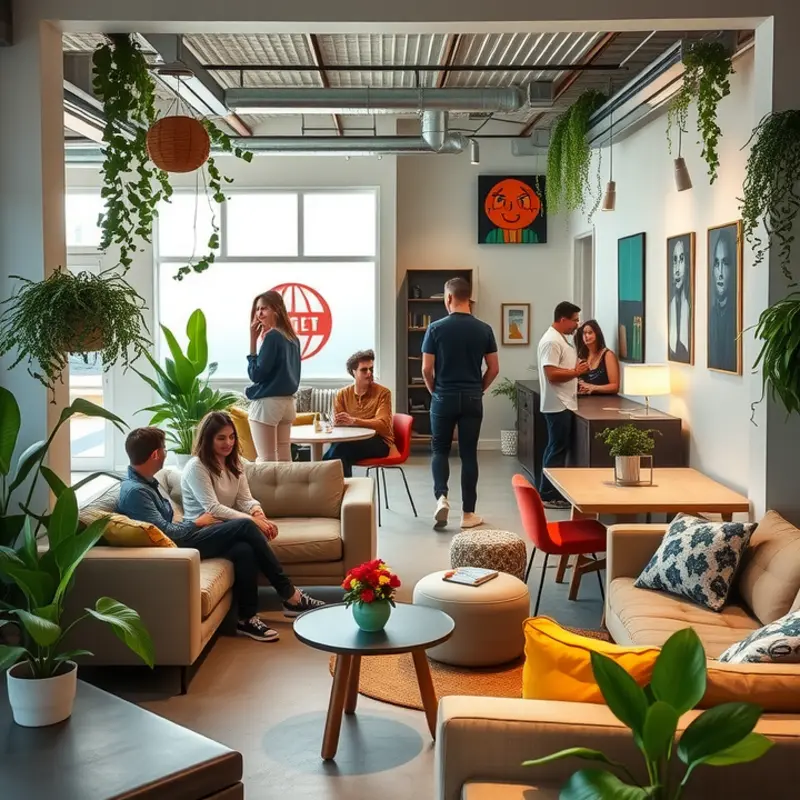Finding a new place to live can feel like dating: exciting, overwhelming, and a bit messy. Enter the era of co-living spaces—a revolutionary approach that has taken the renting scene by storm. These communal havens cater to young adults, first-time renters, and even families looking for balance, connection, and, yes, a sprinkle of fun! With shared amenities, cultural events, and a chance to meet like-minded folks, co-living offers a lifestyle that goes beyond four walls. Imagine sharing a rooftop garden, bonding over Netflix marathons, or even hosting potluck dinners with your housemates! And the best part? You get the perks of community without the dramas of traditional roommate situations. In a world where isolation often feels like the norm, co-living spaces hold out the promise of connection, collaboration, and creativity.
What Are Co-Living Spaces?

Co-living spaces represent an innovative shift in the rental market, emphasizing community and collaboration. Unlike traditional apartment complexes, co-living environments offer a unique blend of private and shared spaces, designed to foster interaction among residents. These spaces often include shared amenities such as kitchens, lounges, and workspaces, creating a sense of community while maintaining individual privacy.
For young professionals, co-living provides an appealing balance between cost and convenience. The inclusion of utilities and services in the rent simplifies budgeting, reducing financial stress. Moreover, co-living facilitates networking opportunities, connecting like-minded individuals in an organic manner. Whether it’s a weekly social event or impromptu gatherings in communal areas, residents enjoy ample opportunities to build both personal and professional relationships.
Families, too, are drawn to co-living for its supportive environment. Access to shared resources like playrooms and gardens is particularly attractive to families with young children. This setup allows parents to share childcare duties with other residents, fostering a close-knit community that often feels like an extended family.
Furthermore, co-living spaces strategically address the needs for flexible living arrangements. Many cater to remote workers by offering high-speed internet and dedicated co-working spaces within the building. This is particularly beneficial given the rise of remote work, which shows no sign of slowing down.
Design-wise, co-living spaces are often cutting-edge, blending aesthetics with functionality. These locations integrate sustainable practices, appealing to eco-conscious residents. From energy-efficient appliances to innovative waste management systems, these amenities align with a growing desire for environmentally responsible living.
Security is another critical component of co-living environments. Many feature advanced security systems that provide peace of mind for all residents. Additionally, the close community bonds formed in these spaces often translate into a heightened sense of security, as neighbors look out for one another.
Another appealing aspect is the ability to customize living spaces without the commitment of long-term leases. This flexibility attracts travelers and professionals on short assignments who seek a home-like environment without the permanence of a traditional lease.
For those considering this lifestyle, exploring some creative lighting ideas could enhance the aesthetic appeal of their living spaces. With the right decor choices, residents can personalize their space, making it feel uniquely their own within the communal setting.
Co-living redefines conventional rental models, offering a harmonious blend of community, flexibility, and modern living. Whether for singles, families, or digital nomads, these spaces can offer the perfect solution, catering to evolving needs and promoting a supportive, collaborative, and dynamic living experience.
The Perks of Living Together

Co-living spaces have revolutionized how many individuals view renting, offering an array of benefits that appeal to a broad demographic. Cost savings stand as a primary reason why people are drawn to this modernized living arrangement. Sharing common areas like kitchens and living rooms allows residents to split expenses. The result is a significant reduction in monthly rent and utility bills compared to conventional renting.
Another appealing aspect of co-living is the flexibility of lease terms. Traditional apartment leases often require long-term commitments, which may not suit everyone’s lifestyle. Co-living spaces often offer more adjustable leasing terms, which can range from a few weeks to several months, allowing residents to adapt to their changing life circumstances more fluidly.
Beyond financial aspects, co-living fosters a sense of community often missing from typical apartment buildings. With shared spaces come shared experiences, making it easier for residents to form friendships and social networks. Regular communal events, like dinners or game nights, provide natural opportunities for connection and camaraderie, reducing the loneliness that can sometimes accompany city living.
This environment is particularly beneficial for professionals and digital nomads who may move frequently and need a social framework immediately available in their new locale. Co-living spaces are designed to facilitate networking among like-minded individuals, hosting events that enable collaboration, both professionally and personally. This atmosphere can lead to unexpected partnerships and lifelong friendships.
Safety and convenience are also paramount in co-living arrangements. Many spaces offer features that cater to modern needs, such as convenient locations near city centers and public transport. Some even include amenities like cleaning services and gym access. Given the communal setup, there’s also often a greater emphasis on safety, providing peace of mind for residents.
Moreover, the opportunity to share resources extends beyond the financial. Residents frequently exchange skills and knowledge, such as cooking tips or language learning, enriching their lives beyond the boundaries of traditional living. For those interested in learning how to maximize the utility of small spaces, exploring creative solutions like those found in tiny kitchens is an exciting endeavor. Learn more about cooking in tiny kitchens here.
Ultimately, the appeal of co-living spaces extends far beyond the practicality of saving money. It offers a holistic lifestyle that balances personal space with community, bringing together diverse individuals under one roof. For those seeking affordability, flexibility, and a built-in community, co-living might just be the perfect match for your renting needs.
Final words
Co-living spaces bring a refreshing twist to the traditional rental market, combining convenience, affordability, and a thriving community atmosphere. Whether you’re a young professional savoring the hustle or a family seeking a supportive environment, these spaces offer something for everyone. By embracing co-living, you can cultivate friendships, share experiences, and enjoy life’s ups and downs with a vibrant tribe by your side. So, if you’re pondering your next rental adventure, why not lean into the trend? Who knows? Your new best friends might be living just a few doors down!









